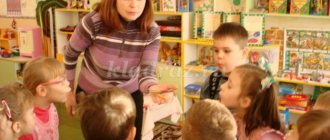Types of retellings
There are other types of retellings:
- Selective. The child can only retell a fragment of the text he heard.
- Brief. You can invite the child to omit unimportant details that will not distort the essence of the entire story. In this case, you need to briefly convey the content.
- Creative. A preschooler can add something of his own to the information, showing a little imagination. Most often, children enjoy coming up with alternative beginnings or endings for stories.
- Without visual support.
When assessing the quality of children's retellings, you need to consider:
- how fully the child conveyed the plot;
- whether the events were presented sequentially, whether the child used cause-and-effect relationships;
- did the child try to use the author’s words or expressions during the retelling, but at the same time did he speak in his own words in order to understand the meaning of the retelling;
- whether the child constructs sentences and uses them correctly;
- Are there any long pauses in his speech due to difficulties in choosing words?
Stories based on plot pictures
The number of pictures in a story series can be increased gradually. Each picture is described in more detail. The description may initially consist of one sentence. But over time, the child must learn to use several.
As a result, the preschooler must understand that the story must be carried out in a sequence based on the arrangement of the pictures. We need to move away from the childish rule: say what you remember.
We compose a story based on one picture with a plot.
When composing a story based on one plot picture, you need to select illustrations that meet the following requirements:
- the illustration should be bright and interesting to the child;
- the plot should be easily understood by children at this age;
- the picture can depict a few active characters;
- there is no need to select pictures that have a lot of different details that are not related to the main content.
You can ask your preschooler to think about how to name the picture. He must understand what the meaning of the illustration is and decide how he relates to it. You can first think about the content of the conversation and what questions you can ask the student.
Here are some examples of plot paintings:
When work is done on developing the ability to retell, the preschooler develops memory and attention. It also has a positive effect on the development of logical thinking, and the active vocabulary is replenished. The preschooler masters grammatical speech patterns and adopts ready-made patterns of speech construction.
Stimulating speech activity
The following requirements are imposed for children’s speech activity:
- The speech must be meaningful. The child must understand well what he is talking about.
- Thoughts are conveyed completely, there are no nouns that would violate the logic of presentation. There are also no gaps.
- The speech is consistent.
- The dictionary is used widely; antonyms and synonyms and other lexical units are heard in speech.
- Speech is rhythmic and there are no long pauses.
Speech must comply with the rules of presentation culture:
- When making statements, the child must take a calm and correct posture and be able to address the audience.
- His speech should be expressive intonation.
- It should be loud enough.
- Pronunciation must be clear.
During classes you can use techniques such as:
- assessment of speech activity;
- demonstration of visual aids.
We try to find combinations of different techniques that would be most effective in order to increase independence and initiative in speech in preschoolers.
What techniques are used to achieve these goals, as well as their choice, constantly changes as we move to the next stage of training. After all, at each stage new tasks are set. The degree of preparation of the children themselves, their activity and ability to show independence also changes.
Characteristic speech impediments
Preschoolers who are part of a speech therapy group have characteristic speech deficiencies:
- They do not know everyday words well or use them inaccurately. Their active vocabulary is filled with verbs and nouns.
- They incorrectly use case endings, mix different aspectual and tense verb forms, and have virtually no knowledge of word formation methods.
- The speech of such children is filled with simple sentences. They don't know how to complicate things. They use subordinate and composed clauses in their speech.
- There are deficiencies in the pronunciation of sounds, the structure of the word is disrupted. This does not make it possible to master the synthesis and analysis of sound composition.
- Children do not know many everyday words, so they are forced to replace them with ones that are close in meaning or sound.
Connectivity of monologue and dialogic speech
Coherent speech can be either monologue or dialogic. Each of them has a feature.
Dialogue speech is usually filled with monosyllabic and incomplete answers. The person's sentences are incomplete. He often uses interjections and exclamations. His speech is bright and expressive. He also actively works with facial expressions and gestures. For speech to be dialogical, you need to be able to correctly ask and formulate your questions.
You also need to make the necessary remarks, correct and supplement your interlocutors. Dialogue is also the ability to argue and reason. You need to defend your position with motivation.
Independent story
When moving on to an independent story, you need to take into account that only children with good preparation are capable of this. This, in turn, depends on the systematicity of the classes. Most often this is associated with stories from children’s personal experiences.
Such a story forces the preschooler to independently find the right words, formulate sentences correctly, and determine in what sequence events should occur.
Therefore, at first, independent stories should be small and related to real or visual situations. This will help the child revive his vocabulary, increase motivation to complete the exercise and make the task easier.
Independent stories can be prepared on the following topics:
- a day spent in kindergarten;
- impressions received from visiting any event;
- a walk in the forest or somewhere else.
So, today many effective methods and methods for forming coherent speech in preschoolers in a speech therapy group have been developed and tested. All these methods are based on the gradual complication of work. Children must increasingly demonstrate independence in composing sentences.
As a result, their level of development of coherent speech increases, which is useful for mastering the basic education programs for preschoolers in kindergarten.
Objectives of speech therapy classes
Teachers in a speech therapy group should try to accomplish the following tasks:
- develop each speech component;
- develop interest in the activities that are offered to the child;
- introduce the child to the cognitive process;
- develop different ideas in children;
- replenish preschoolers’ knowledge of the world around them.
Project activities allow you to maximally integrate several techniques into one lesson. A speech therapist can conduct speech therapy sessions and include small episodes of different types of activities. Educators can integrate certain types of activities into their classes.
Integration is what allows a child to start thinking and imagining, creating and learning something, composing and communicating. This fills the vocabulary of words and develops the degree of mastery of grammar.
Preschoolers develop cognitive abilities. Tasks and questions from the teacher force preschoolers to more actively use their speech experience. They begin to apply this experience in real life, as well as in non-standard situations.
Methods of teaching coherent utterances
These classes should also include various methods of a traditional and non-traditional nature. The main thing is to stimulate the speech activity of preschoolers and develop it.
If you include different types of activities in your classes, you can achieve a high level of effectiveness when working with preschoolers who have speech disorders. As a result, the results are stable.
Here are some techniques you can use to develop coherence in speech:
- conversation with a preschooler using bright illustrations, various intonations, gestures and facial expressions.
- reading fairy tales and other works of literary art.
The teacher can ask the child questions about what was written in the fairy tale he read. This way you can understand whether the child understood the cause-and-effect relationships in the work.
- Does he see why the event happened?
- Does he notice who is to blame for what happened?
- Can a child give an evaluative description of the actions of the heroes?
The fact that a child can retell a story in his own words indicates an understanding of its meaning.
There are different topics that can be discussed: excursions and books. You can also talk about cartoons and movies. Conversations can also be conducted using pictures. A preschooler needs to be taught to listen to his interlocutors and not interrupt them.
You also need to learn to follow the progress of someone else’s thoughts. During the conversation, the adult can gradually increase the difficulty of the questions. You need to start with more specific questions.



